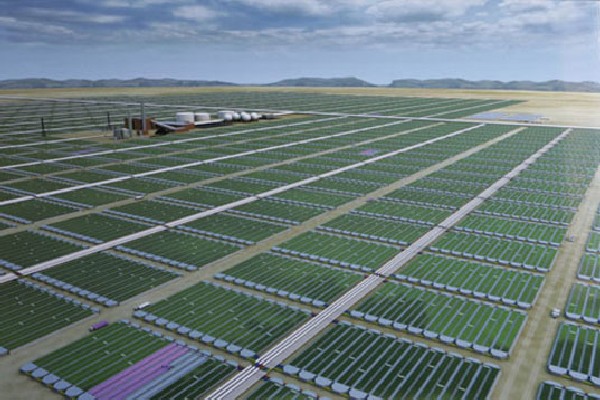
What’s happening right now?
Declining global oil productive capacity combined with a growing oil demand in developing countries provides the most compelling global reason for alternative fuels. The current strain on petroleum supply has pushed petroleum product prices up. On the oil supply side, there are no major undiscovered oil reserves which can significantly add to global supply. Moreover, man-made emissions, particularly from the burning of fossil fuels, are contributing to environmental pollution and hence resulting in global climate change.
Biofuels are gaining increased public and scientific attention, driven by factors such as oil price spikes, the need for increased energy, and concern over greenhouse gas emissions from fossil fuels. The production of biofuels from algae could be a meaningful part of the solution in the future because of its potential as an economically viable, low emissions transportation fuel.
TRENDS
1. Aquaflow and Solray’s joint venture to convert algae into biofuel
New Zealand algae-to-biofuel hopefuls Aquaflow Bionomics and Solray Energy have teamed up to see if they can overcome the challenges that have kept algal biofuels from commercial production to date. The partnership will combine Aquaflow’s methods of harvesting algae grown from wastewater streams and Solray’s process of turning that algae into fuel. Their work will target global demand for clean water, reduction of nitrogen and phosphates which have seriously degraded aquatic ecosystems, and renewable biofuels from waste.
Algae may be the miracle element in the search for a more environmentally-friendly, mass-produced product that can be converted into fuel. Algae grow naturally all over the world. Under optimal conditions, it can be grown in massive, almost limitless, amounts and their growth rate than other crops. Scientists have been studying algae’s lipid oil for decades to convert it into algae biodiesel — a fuel that burns cleaner and more efficiently than petroleum. Algae are excellent bioremediation agents – they have the potential to absorb massive amounts of CO2 and can play an important role in sewage and wastewater treatment.
Butanol can be used in gasoline engines without engine modification. It is a promising fuel that can be used instead of ethanol and methanol. The energy density of butanol is 10% less than gasoline but more than that of either ethanol or methanol. Butanol is less corrosive and hence can be more easily transported over pipes.Diatoms or algae can be used as the raw organic material for butanol production which can be powered by 100% solar energy. Butanol is prepared by the green waste that is left over after the production of oil from algae.
Biogasoline is a gasoline produced from biomass such as algae, crops, and animal fats. It is chemically different from the gasoline we know today, which is alcohol. Biogasoline is actually hyrdrocarbons containing 6 (hexane) to 12 (dodecane) carbon atoms per molecule. It is very similar to gasoline and 100% biogasoline will actually work in a modern gasoline engine as a drop-in substitute for petroleum gasoline.
Methane, in a blend of other gases, can be produced from biomass by a biochemical process called anaerobic digestion and can be utilized to replace energy derived from fossil fuels, and hence reduce emissions of greenhouse gasses.The production of methane from algae is usually not a one-step process. It requires the manipulation of a set of bioreactions beginning with the treatment of algae as simply sources of cellulose, with the object of maximizing the output of acetic acid and acetates which are then subjected to methanogenic reaction to produce methane. Methane in the form of compressed natural gas is used as a vehicle fuel, and is claimed to be more environmentally friendly than fossil fuels such as gasoline/petrol and diesel.
The concept:
Researchers at Rochester Institute of Technology are developing biodiesel from microalgae grown in wastewater. The project is doubly “green” because algae consume nitrates and phosphates and reduce bacteria and toxins in the water. The end result is clean wastewater and stock for a promising biofuel. The purified wastewater can be channelled back into receiving bodies of water at treatment plants, while the biodiesel can fuel buses, construction vehicles and farm equipment. Algae are much simpler organisms using photosynthesis to convert sunlight into energy. They need only water of ponds or tanks to grow in sunlight and carbon dioxide.
The production of algae has been increased from 30 gallons to 100 gallons and hopes to expand to 1,000 gallons by spring, as the team from the Environmental Energy Technologies hopes algae to be the fuel of the future.
The advantages:
There are many advantages to this approach over using food crops to produce fuel. Algae must be grown in tanks. These tanks can be put anywhere where there is a lot of sunlight and this does not impact on the amount of available farming land. The other major advantage is that algae reproduce far more quickly than crop plants and do not require fertilizers for their growth.
Useful algae can be grown in sea water so there is no need to use precious drinking water to grow the fuel. Algae Oil Extracts can be used as livestock feed and even processed into ethanol. The yield of vegetable oil from algae is comparatively much higher (about 30 times) than land crops.
Algae have the highest rate of consumption of CO2 out of every known plant. When the algae are being produced it actually requires CO2 as an input to grow instead of the huge output of CO2 produced by the burning of petroleum products. Algae biodiesel has virtually no sulphur content. It is non-toxic, highly biodegradable and this biofuel can be used in gasoline engine without varying the engine.
The impact:
Algae fuel is an alternative to fossil fuel and uses algae as its source of natural deposits. Several companies and government agencies are funding efforts to reduce capital and operating costs and make algae fuel production commercially viable. The biofuel produced from algae amounts to a minimal reduction of CO2 as the CO2 consumed by the algae is returned to the atmosphere when the biofuel is burned.
As an environmentally sustainable alternative to current algae production methods, the researchers propose situating algae production ponds behind wastewater treatment facilities to capture phosphorous and nitrogen which are essential nutrients for growing algae. Those same nutrients are discharged to local waterways, damaging the water bodies.
While the researchers found algae production to have a greater environmental impact than other sources, it remains an attractive source for energy. Algae, which are grown in water, don’t compete with food crops grown on land and also tend to have higher energy yields than sources such as corn or switchgrass.
The algae industry can proactively address sustainability issues by conducting and publishing techno-economic and life cycle analyses, water balances, and energy and carbon balances, feasible, adopting low-impact development, operations, and maintenance practices.




